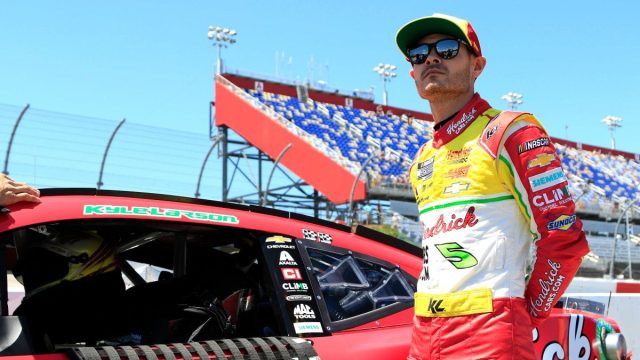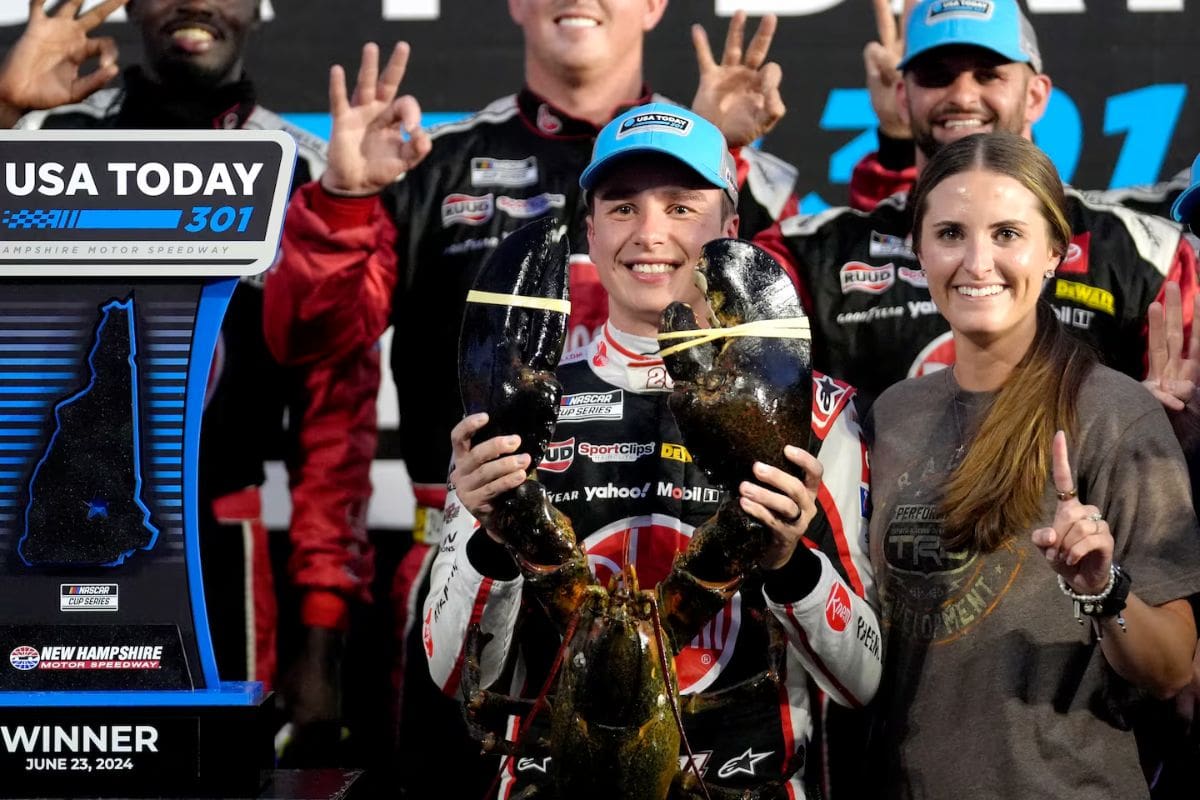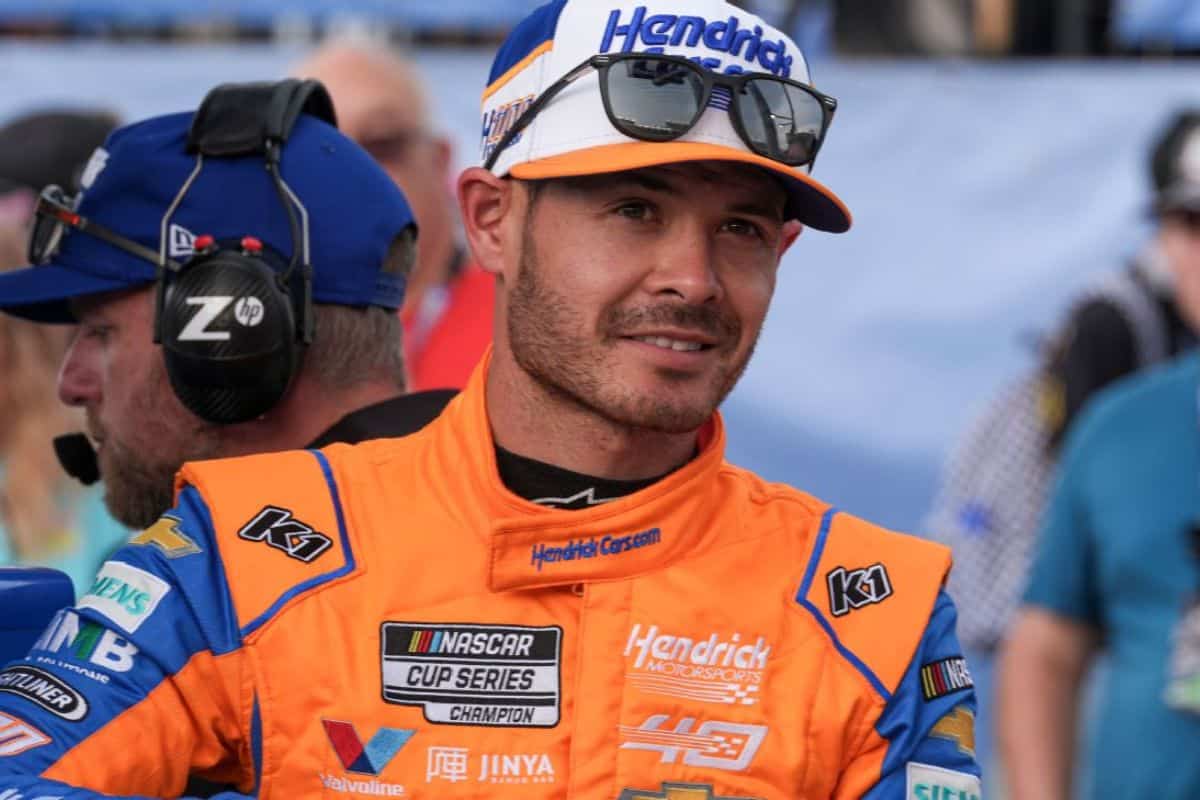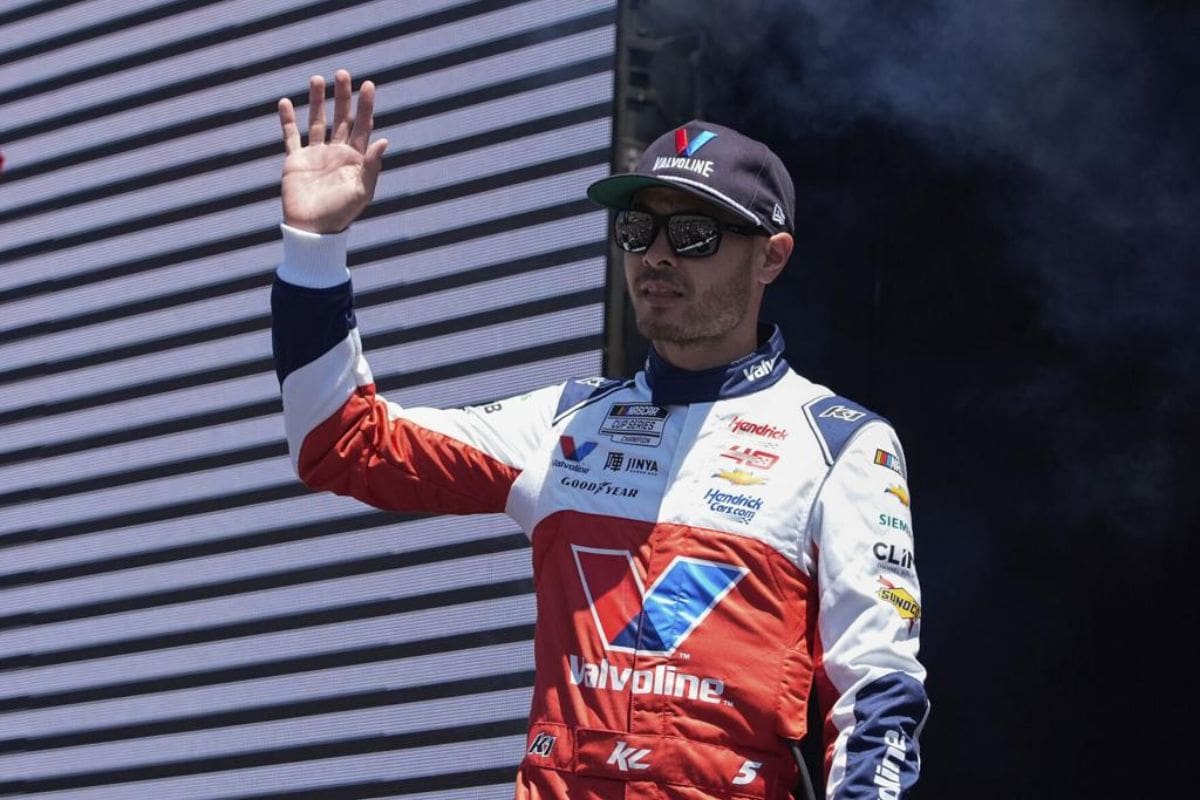Kyle Larson Criticizes NASCAR’s Hesitation: Kyle Larson‘s recent critique of NASCAR’s hesitation during the wet track conditions at the Coca-Cola 600 has pointed a significant debate within the motorsports community. Larson pointed out the delayed response in switching to slick tires as the track began to dry, which he argued compromised both performance and safety. This incident highlights broader concerns about NASCAR’s race management strategies under unpredictable weather conditions. As teams and drivers navigate these challenges, Larson’s feedback might serve as a crucial moment for NASCAR to evaluate and potentially improve their protocols, aiming for a more adaptive and responsive approach in future races.
Key Highlights
- Kyle Larson criticized NASCAR’s hesitation to switch from wet tires, worsening traction issues on the drying track.
- Larson highlighted the rapid deterioration and overheating of wet tires, impacting race performance.
- NASCAR’s delay in tire change decisions showed a disconnect with evolving track conditions.
- Larson’s feedback emphasized the need for NASCAR to refine strategies for weather-affected races.
- The critique reflects Larson’s desire for improved race management and adaptability in adverse conditions.
Christopher Bell’s Dominance at NHMS
Christopher Bell’s performance at the New Hampshire Motor Speedway was nothing short of dominant, as he led the field with a commanding presence that left his competitors scrambling to keep pace. From the drop of the green flag, Bell displayed his exceptional skill and strategic expertise, driving the track with precision and maintaining a consistently high speed. His ability to manage tire wear and fuel consumption contributed greatly to his formidable lead, demonstrating both his driving skills and the strength of his team’s preparations.
Behind Bell, the Stewart-Haas Racing teammates Chase Briscoe and Josh Berry were locked in a battle for positioning, each working hard to close the gap but ultimately unable to match Bell’s pace. Briscoe’s and Berry’s efforts, while commendable, were overshadowed by Bell’s relentless determination. This internal team rivalry did, however, add an element of excitement to the race.
Kyle Larson, representing Hendrick Motorsports, emerged as a notable contender initially, holding a strong fourth-place position. Larson’s early race performance imply at potential challenges to Bell’s dominance, but fluctuating weather conditions played a crucial role in his eventual decline. The changing weather, which included a significant rain delay towards the end of the final stage, disrupted Larson’s rhythm and strategy. Despite his efforts, the conditions ultimately favored Bell’s adaptable approach.
The Race Turns into a Lottery
The race devolved into a chaotic lottery as the erratic weather conditions led to multiple spins, wrecks, and a slew of cautions, severely testing the patience and resolve of both drivers and teams. As the rain unpredictably disrupted the track conditions, drivers found themselves grappling with traction issues, leading to a series of accidents that brought out numerous caution flags. This unpredictable turn of events not only challenged the strategic wisdom of the teams but also plunged the race into an unpredictable spectacle, where luck seemed to play as significant a role as skill.
The relentless sequence of incidents forced teams to continually reassess their strategies, with frequent pit stops becoming a common sight. The tire calls, in particular, were a focal point of debate among drivers, including Kyle Larson, who voiced his frustrations over what he perceived as questionable decisions amidst the changing conditions. The chaotic nature of the race rendered traditional strategies almost obsolete, as drivers struggled to maintain control on the slick surface.
From an insider perspective, the race at New Hampshire Motor Speedway highlighted the critical importance of adaptability in motorsports. Teams had to swiftly pivot their game plans in response to the erratic weather, while drivers needed to balance aggression with caution to navigate the treacherous track. This drastic shift in dynamics emphasized the inherent unpredictability of racing under such volatile conditions, transforming what began as a contest of speed and skill into a lottery where fortune favored the resilient and adaptable.
Kyle Larson’s Strategy in turbulent conditions that turned the race into a gamble, Kyle Larson’s strategic approach involved capitalizing on the opportunity to change tires, which ultimately proved essential in navigating the challenging track.
As the race neared its end, the track conditions remained tense, creating a precarious scenario for all drivers. Larson found himself in a tough spot, but the opportunity to slap on a new set of tires during the last 10 laps provided a much-needed break.
In a post-race interview with Bob Pockrass, Larson explained the significance of this tire change. The strategic move allowed him to better handle the drying surface, which was evolving from wet to a state more suitable for slicks.
Larson’s insight into the final laps highlights the delicate balancing act faced by drivers. He acknowledged that had the race continued without interruption, driving the drying track on wet tires would have been difficult, potentially altering the race outcome.
“Honestly, it didn’t matter. Just being able to put on tires is probably good. I think that last little 10-lap segment kind of got broken, and that helped things. Had you gone 10 laps straight on the dried surface, it would have been difficult. Maybe that would have made for a better finish, who knows? This track was definitely ready for slicks.” – Larson
Kyle Larson, Chase Briscoe and Michael McDowell had positive reviews of the use of the wet weather tires. Should they have gone to slicks? Should they have had a chance to choose which tires to put on? Some of the thoughts: pic.twitter.com/RsF7GSnobS
— Bob Pockrass (@bobpockrass) June 24, 2024
Larson’s approach emphasizes the importance of tire strategy in unpredictable conditions. While NASCAR’s mandate to remain on wet tires added a layer of complexity, the ability to adapt and capitalize on available opportunities was vital.
Issues with Wet Tires on a Dry Track
Driving on a drying track with wet tires posed a significant challenge, as the lack of grip forced drivers to proceed with extreme caution and contributed to numerous incidents throughout the race. The hesitation of NASCAR officials to switch to slick tires, even as the track conditions improved, exacerbated the situation, leading to a series of on-track mishaps and cautions.
The race saw a parade of caution flags, with multiple drivers, including notable figures like Kyle Busch and Corey LaJoie, experiencing wrecks. The issues were not isolated, as Bubba Wallace and Noah Gragson, among others, also found themselves struggling to maintain control. As the track dried, the performance of wet tires deteriorated rapidly. Wet tires, designed for peak performance in rain conditions, become a liability on a dry or drying surface. The tread, meant to channel water away and provide grip, overheats and loses its effectiveness, leading to a severe reduction in traction.
From an insider perspective, the decision to delay the switch to slick tires can be seen as a cautious approach aimed at ensuring safety. However, it ultimately resulted in a counterproductive effect, as drivers were forced to navigate a perilous track with subpar equipment. The continuous string of incidents highlighted the disconnect between track conditions and the tire choices mandated by the officials.
Reflections on the Race’s Completion
Reflecting on the outcome of the race, Kyle Larson expressed a thoughtful appreciation for the event’s completion despite the challenging weather conditions that tested both drivers and officials. Having previously experienced the frustration of a weather-cancelled event during the Coca-Cola 600 at Charlotte Motor Speedway, Larson found comfort in seeing this race through to the end. He noted the importance of completing the race, emphasizing the resilience of both the teams and NASCAR in managing the adverse conditions.
“Yeah, for sure, I’m definitely happy with that. It was great, I think I went forward – obviously our cars operate fine in damp conditions – I wish we could spend more time drying pit road. That way we could have strategy”.
“Mandate us, put on the damps or the wet tires, and after that, it’s up to us. I think if they could spend more time drying pit road, rather than the track, it would make for a way more exciting strategy-style race. More comers and goers, people making daring moves with slicks on the wet surfaces, trying to get by people. Hopefully, they are inching towards that. We got enough data points now to see that the track dries extremely fast when you get out there.” – Larson
- Completion Over Cancellation: Larson’s satisfaction with the race’s conclusion emphasizes the significance of perseverance. After the disappointment of the weather-interrupted Coca-Cola 600, finishing this race was a moral victory for him and his team.
- Strategy and Excitement: Despite his criticisms, Larson acknowledged the potential for more strategic depth if NASCAR had experimented with drying pit roads and enforcing mandatory wet tires. He believes such adjustments could have led to a more dynamic race with increased strategic diversity and daring moves, adding an element of excitement.
- Learning Opportunities: Larson hopes NASCAR will learn from this experience. He pointed out that the track dries quickly once cars are on it, suggesting that future races could benefit from this understanding. By refining their approach to weather-affected races, NASCAR can improve both safety and entertainment value.
News in Brief: Kyle Larson Criticizes NASCAR’s Hesitation
The analysis of Kyle Larson’s criticism emphasizes the necessity for NASCAR to improve decision-making processes in dynamic track conditions. Highlighting the challenges with wet tires on a drying track, Larson’s feedback indicates the need for more agile and responsive race management strategies.
This incident serves as a critical case study for NASCAR, highlighting the importance of timely adaptations to maintain safety and competitiveness, thereby potentially driving significant improvements in the sport’s operational protocols.
Our Reader’s Queries
Q. Why is Kyle Larson called Yung Money?
A. During his teenage years, Larson competed in open-wheel cars such as the United States Auto Club (USAC) midgets, Silver Crown, and sprint cars. He raced for Keith Kunz Motorsports and Hoffman Racing with support from Toyota. In his early USAC career, Larson earned the nickname “Yung Money” from a series official, acknowledging his exceptional talent.
Q. What is Kyle Larson’s heritage?
A. After making a significant impact in dirt track racing, Larson burst onto the NASCAR scene in 2012. Hailing from Northern California with Japanese heritage, he swiftly advanced to a full-time position in the prestigious NASCAR Cup Series. Known for his impressive racing prowess, Larson garnered praise and established himself as a consistent contender in the playoffs.
ALSO READ: Kyle Larson Talks Chevy’s NASCAR Struggles at New Hampshire



